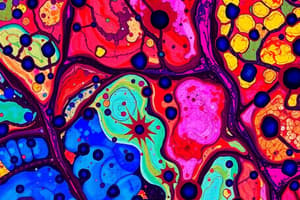Podcast
Questions and Answers
What is the main difference between physical and chemical staining?
What is the main difference between physical and chemical staining?
- Physical staining is typically used for plant cells, while chemical staining is reserved for animal cells.
- Physical staining involves absorption, whereas chemical staining requires a chemical reaction with the structure. (correct)
- Physical staining uses reactive dyes while chemical staining does not.
- Physical staining results in permanent color changes, while chemical staining is temporary.
Which of the following is an example of a basic stain?
Which of the following is an example of a basic stain?
- Sudan III
- Hematoxylin (correct)
- Eosin
- Carmine
What is the characteristic of metachromatic stains?
What is the characteristic of metachromatic stains?
- They react with substances to give the same color as the stain.
- They are primarily used for staining the cytoplasm.
- They consist of only one dye used in the staining process.
- They cause a color shift that is different from the original color of the stain due to interaction with the content. (correct)
Which of the following statements about staining techniques is accurate?
Which of the following statements about staining techniques is accurate?
Which statement correctly describes a pigment stain?
Which statement correctly describes a pigment stain?
What characterizes the regressive method of staining?
What characterizes the regressive method of staining?
Which of the following best describes supravital stains?
Which of the following best describes supravital stains?
What is the main purpose of applying a mordant in staining techniques?
What is the main purpose of applying a mordant in staining techniques?
In the context of trichrome stains, vital staining primarily refers to which of the following?
In the context of trichrome stains, vital staining primarily refers to which of the following?
Which method involves sectioning specimens before staining?
Which method involves sectioning specimens before staining?
Flashcards
What is a stain?
What is a stain?
A substance that adheres to a cell and colors it, making it more visible under a microscope.
What are physical stains?
What are physical stains?
Physical stains combine physically with the structure they stain.
What are acid stains?
What are acid stains?
Acid stains are colored by acid radicals.
What is the difference between monochromatic and polychromatic staining?
What is the difference between monochromatic and polychromatic staining?
Signup and view all the flashcards
What is metachromasia?
What is metachromasia?
Signup and view all the flashcards
Trichromatic Stain
Trichromatic Stain
Signup and view all the flashcards
Staining in toto
Staining in toto
Signup and view all the flashcards
Section staining
Section staining
Signup and view all the flashcards
Vital Stains
Vital Stains
Signup and view all the flashcards
Progressive Staining Method
Progressive Staining Method
Signup and view all the flashcards
Study Notes
Staining Techniques
- Stain: A substance that adheres to a cell, giving it color. Color provides contrast, making cells more visible under a microscope.
- Dye: Synthetic stains.
- Pigment: Stains extracted from plants or animals.
- Staining Technique: A microscopy method for enhancing contrast in images.
Classification of Stains
- Origin:
- Animal origin (e.g., carmine from insect bodies).
- Plant origin (e.g., hematoxylin from the Mexican tree).
- Synthetic (e.g., eosin).
- Mode of action:
- Physical staining: The stain physically combines with the structure by absorption. (e.g., Sudan III, stains fats orange-yellow).
- Chemical staining: The stain chemically reacts with the structure (e.g., various stains for DNA).
- End color of stained content:
- Orthochromatic: The stain reacts with the cell content, resulting in the same color. (e.g., cytoplasm with methylene blue gives a blue color).
- Metachromatic: The stain reacts with the cell content and produces a different color. (e.g., starch with iodine solution gives a blue color).
- Metachromasia: The reaction between the stain and the content results in a color different from the stain's original color.
Classification of Staining Techniques
- Number of stains used:
- Monochromatic (simple): Uses one dye.
- Polychromatic (multiple): Uses several dyes. Multiple dyes allow different structures to be stained in different colors (e.g., trichrome stain uses three dyes for color differentiation).
- Nature of stained material:
- Staining in toto: Staining the entire tissue mass.
- Section staining: Staining sections of the tissue. This method firstly sections the specimen, and then stains the separated sections.
- Applied method:
- Regressive: Over-staining followed by removal of excess stain to reach the desired intensity.
- Progressive: Sections are gradually stained until the desired intensity is reached.
- Mordant use: Using a mordant to fix the stain better to the tissue. The mordant is a chemical that aids stain fixation and helps in more intense coloring. (e.g., in Gram staining and iodine solution procedure for crystal violet)
- Special methods: Specialized methods like fluorescent and electron microscopy.
Vital Staining
- Stains that can diffuse through living tissues without harming them.
- Intravital: Staining living cells inside the body (in vivo).
- Supravital: Staining living cells outside the body (in vitro).
Other Concepts
- Acidophilic: Substances that have an affinity for acid stains.
- Basophilic: Substances that have an affinity for basic stains.
- Eosin stain: A stain that stains cytoplasm, usually pink.
- Basic fuchsin: A stain that stains DNA, often creating a pink/purple color.
- Neutral Stains: Stains with both acid and base radicals. These stains are utilized in blood cell staining.
Studying That Suits You
Use AI to generate personalized quizzes and flashcards to suit your learning preferences.




